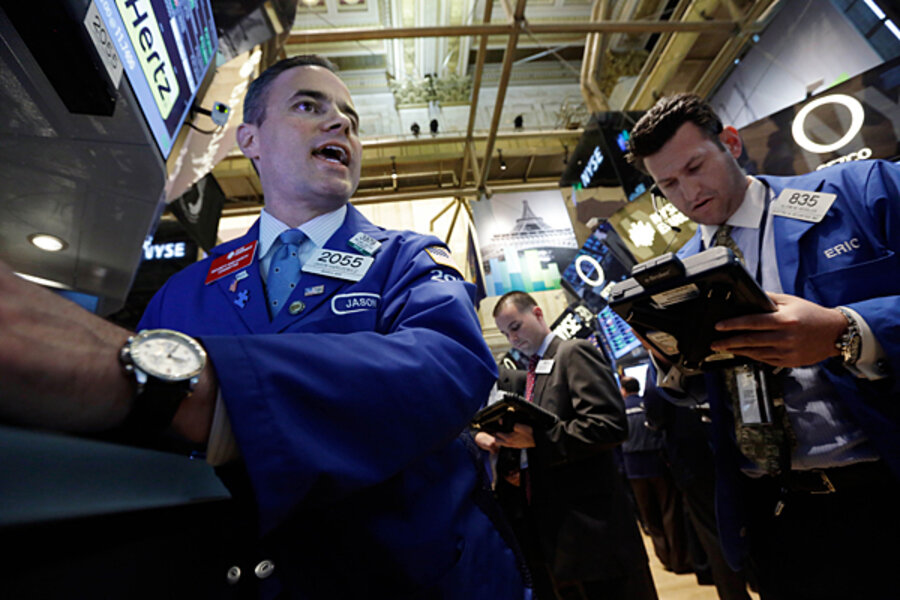Stocks advance to begin month
Loading...
| New York
Investors have stopped worrying about the Federal Reserve. At least for now.
Stocks rose on Wall Street Monday as investors judged that the economy still isn't growing fast enough for the central bank to cut back on its stimulus program.
U.S. manufacturing grew modestly in June after a pickup in new orders and stronger production, according to a private survey. The Institute for Supply Management said its factory index increased to 50.9 in June from 49 in the previous month.
The Standard & Poor's 500 index logged its first monthly decline since October last month after investors were unsettled by comments from Federal Reserve Chairman Ben Bernanke. Bernanke said last month that the Fed could ease back on its stimulus later this year and end it next year, providing the economy continues to recover.
"The market has ... stepped back from the knee-jerk reaction that the Fed news provided," said Jim Russell, a regional investment director at US Bank. "The manufacturing ISM number came in strong enough — not too hot, not too cold."
If the manufacturing report had been stronger, Russell said, stocks might have fallen as investors speculated that the Fed would be inclined to ease back on its stimulus sooner.
A separate report on construction spending added to the picture of a gradually improving economy. Construction spending rose 0.5 percent in May compared with April, when spending was up 0.1 percent.
The Dow Jones industrial average gained 65.36 points, or 0.4 percent, to 14,974. The Dow gained as much as 173 points in during morning trading before drifting lower throughout the afternoon.
The S&P 500 index rose 8.68 points, or 0.54 percent, to 1,614. The Nasdaq composite rose 31.24 points, or 0.9 percent, to 3,434.
The Fed is currently buying $85 billion of bonds a month to keep interest rates low and encourage borrowing and spending. That stimulus has been a major factor supporting a rally in stocks this year and the threat of it being withdrawn made stock markets more volatile last month.
The S&P 500 closed at a record high of 1,669 on May 21. A day later, stocks began dropping after minutes of a Fed meeting were released suggesting the stimulus could be scaled back. The sell-off picked up pace June 19, when Bernanke laid out a possible road map for ending the bond purchases.
The S&P closed at 1,573 on June 24, almost 6 percent down from its record, before regaining some of its loss. The index is still up 13.2 percent this year.
The market is more than twice as likely to gain as decline on the first trading day of a new quarter, according to data from S&P Dow Jones Indices. The index has risen 27 times and fallen 13 times during the past 10 years on the first trading day of the quarter.
"You're seeing new money come in to the markets as we are in a new quarter," said Quincy Krosby, a market strategist at Prudential Financial. "New money is being put to work."
Eight of the 10 industry groups that make up the S&P 500 index rose, led by materials companies, a category that includes miners and chemical makers, and industrial companies. Utilities and phone companies were the only ones to decline.
This week's most closely watched economic release will be the government's monthly employment report Friday. Economists expect the U.S. added 165,000 jobs in June, a figure that would affirm the economy's steady, but slow, trajectory, said Scott Wren, a senior equity strategist at Wells Fargo Advisors.
"It's a confirmation of more of the same," said Wren. "More modest growth, more modest inflation, but not a big acceleration."
U.S. stocks also followed global markets higher. Japan's Nikkei 225 rose 1.3 percent, boosted by signs of improvement in Japan's economy.
In Europe, stock indexes rose after a mixed set of economic indicators for the region. While unemployment in the 17 countries that use the euro rose to another record high in May, manufacturing picked up in Britain, France and Italy and stabilized in Spain.
Germany's DAX index rose 0.3 percent and Britain's FTSE 100 index climbed 1.5 percent.
The yield on the 10-year Treasury note was unchanged from Friday at 2.49 percent. The note's yield surged to 2.66 percent last Monday as investors worried that the Fed was poised to reduce on its bond purchases. The yield on the 10-year Treasury note is used to set interest rates on many kinds of loans including home mortgages.
In commodities trading, the price of oil climbed $1.43, or 1.5 percent, to $97.99 a barrel. The price of oil rose on concerns that unrest in Egypt, the largest Arab nation, could spread and affect the transport of oil supplies in the Middle East and Africa.
Gold rose $32, or 2.6 percent, to $1,255.70 an ounce.
Trading will be curtailed this week due to the Independence Day holiday Thursday. The New York StockExchange will close at 1 p.m. on Wednesday and reopen on Friday.
The dollar edged lower against the euro and rose against the Japanese yen.
Among stocks making big moves:
— Onyx Pharmaceuticals surged $44.51, or 51 percent, to $131.33 after the company rejected a takeover bid from Amgen, a larger biotechnology company. Onyx said other companies have expressed interest in a buyout.
— Cablevision rose $1.62, or 9.6 percent, to $18.44 after Reuters reported that Time Warner Cable is considering making a bid for the company.
— Best Buy rose $2.41, or 8.8 percent, to $29.74 after Credit Suisse resumed its coverage of the stock with an "outperform" rating and a target price of $42. Analysts at the investment bank believe that the company's new approach to serving customers will help it increase its earnings.







